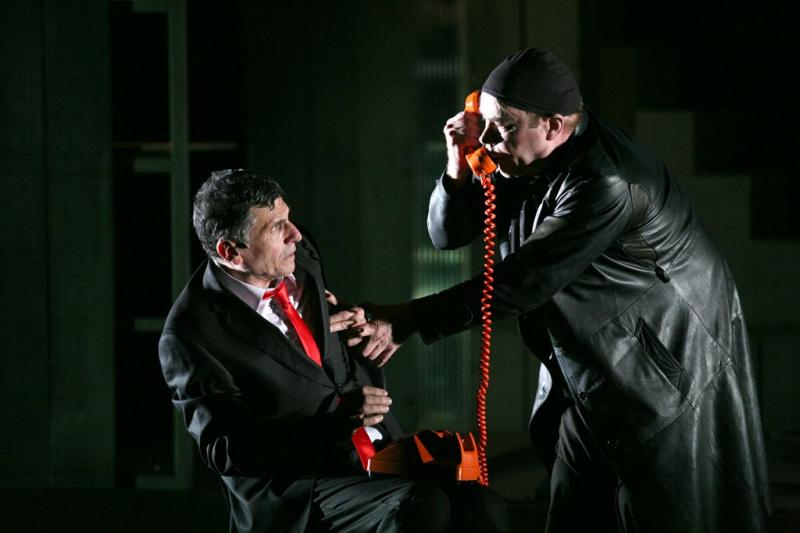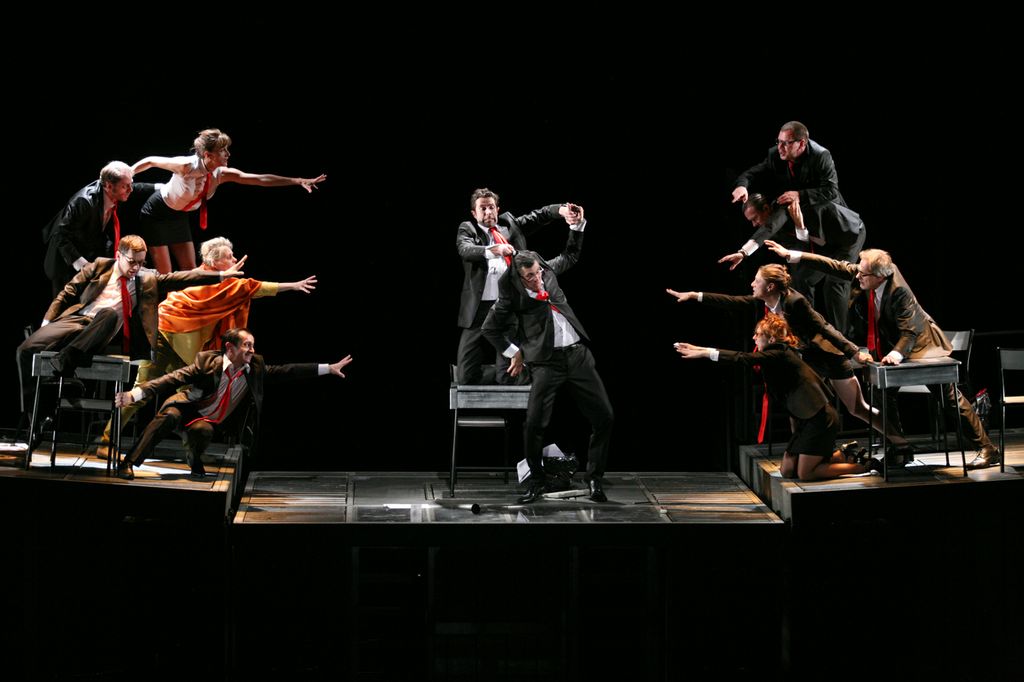Rhinocéros, Barbican Theatre | reviews, news & interviews
Rhinocéros, Barbican Theatre
Rhinocéros, Barbican Theatre
Ionesco's absurdist masterpiece delivered with pace and style by fine French ensemble

I laughed quite a bit going round the exhibition to which the Barbican’s latest theatre events are tied, The Bride and the Bachelors. Pioneer Marcel Duchamp’s 1921 “Readymade” Why Not Sneeze, Rrose Sélavy? is funny in itself: a metal birdcage containing marble sugarcubes with a cuttle bone and a thermometer stuck through the bars.
I laughed a lot, too, reading Eugène Ionesco’s Rhinocéros. I laughed rather less at a production which sometimes squashes the Romanian’s absurdist black humour under elegant French feet. But the Théâtre de la Ville-Paris’s clockwork precision and sure sense of pace do take us to the dark heart of a great play.
Elaborate mobile sets by Yves Collet are artworks in themselvesThe Parisians continue to keep Ionesco in the forefront of the dramatic repertoire while London theatre merely defers to his example in the abstract. Our long runner is The Mousetrap; Paris's is a double bill of Ionesco’s The Bald Primadonna and The Lesson, still to be seen at the tiny Théâtre de la Huchette 61 years after their first performances there.
Théâtre de la Ville parades its Ionesco on a bigger scale with an ensemble of 13 and elaborate mobile sets by Yves Collet which are artworks in themselves – but all in the cause of illuminating Emmanuel Demarcy-Mota’s initially fast-moving production which keeps the fable of Rhinocéros simple yet ambiguous. For Ionesco it was about the rise of Fascism, but as the pachydermal herd lacks a leader, it remains topical – a comic-serious riff on joining the pack, the latest fashion, the current opinion
That it’s the story of one man against a world bent on becoming beasts is made clear immediately by transposing a chunk of monologue for the protagonist, Bérenger, to the beginning of the play, before proper curtain up. He’s played with shabby gentleness by Serge Maggiani, following in the footsteps of Jean-Louis Barrault who created the role in 1960: part Molière outsider-hero, part Shakespearean soothsayer-clown (Demarcy-Mota and artistic collaborator François Regnault make this clear in a programme of enlightening articles, and they certainly practise what they preach). The provincial world in which Bérenger finds himself at odds would be funnier if it were less stylised, more realistic; the absurd breakthrough of an offstage rhino charge would have more of an impact too in the midst of the silly-mundane, but the direction and Jefferson Lembeye’s soundscape are intent on doomy portent. The mass activities of the second act’s office group aren’t terribly amusing either - collective typing on desks apart - until a worker turned rhino breaks down a staircase and the set slides, or rather elevates, into stylised chaos (pictured above).
The provincial world in which Bérenger finds himself at odds would be funnier if it were less stylised, more realistic; the absurd breakthrough of an offstage rhino charge would have more of an impact too in the midst of the silly-mundane, but the direction and Jefferson Lembeye’s soundscape are intent on doomy portent. The mass activities of the second act’s office group aren’t terribly amusing either - collective typing on desks apart - until a worker turned rhino breaks down a staircase and the set slides, or rather elevates, into stylised chaos (pictured above).
As Ionesco’s Theatre of the Absurd turns slowly to tragicomedy, the power of the individual acting beyond the crisp ensemble work asserts itself. Hugues Quester as Bérenger’s bullying friend Jean, a man seen on the edge from the start, convinces us he’s leathering up and turning green before our very eyes. Does the show deliver on Ionesco’s demand for “a lot of rhinoceros heads”? Available images don’t give the game away, so neither shall I; but suffice it to say that the last of the three acts, which run here compellingly without an interval, offers the most painterly visual coup. It’s a love scene with a very unValentineish conclusion between wounded Bérenger and secretary Daisy (Valérie Dashwood) played out in the near-dark. The Barbican Theatre’s black box fits this production as well as the gallery does the superb exhibition; go see them both, but be quick about it if you want to catch this Rhinocéros.
rating
Explore topics
Share this article
The future of Arts Journalism
You can stop theartsdesk.com closing!
We urgently need financing to survive. Our fundraising drive has thus far raised £49,000 but we need to reach £100,000 or we will be forced to close. Please contribute here: https://gofund.me/c3f6033d
And if you can forward this information to anyone who might assist, we’d be grateful.

Subscribe to theartsdesk.com
Thank you for continuing to read our work on theartsdesk.com. For unlimited access to every article in its entirety, including our archive of more than 15,000 pieces, we're asking for £5 per month or £40 per year. We feel it's a very good deal, and hope you do too.
To take a subscription now simply click here.
And if you're looking for that extra gift for a friend or family member, why not treat them to a theartsdesk.com gift subscription?
more Theatre
 Good Night, Oscar, Barbican review - sad story of a Hollywood great's meltdown, with a dazzling turn by Sean Hayes
Oscar Levant is an ideal subject to refresh the debate about media freedom
Good Night, Oscar, Barbican review - sad story of a Hollywood great's meltdown, with a dazzling turn by Sean Hayes
Oscar Levant is an ideal subject to refresh the debate about media freedom
 Edinburgh Fringe 2025 reviews - Monstering the Rocketman by Henry Naylor / Alex Berr
Tabloid excess in the 1980s; gallows humour in reflections on life and death
Edinburgh Fringe 2025 reviews - Monstering the Rocketman by Henry Naylor / Alex Berr
Tabloid excess in the 1980s; gallows humour in reflections on life and death
 Edinburgh Fringe 2025 reviews: Lost Lear / Consumed
Twists in the tail bring revelations in two fine shows at the Traverse Theatre
Edinburgh Fringe 2025 reviews: Lost Lear / Consumed
Twists in the tail bring revelations in two fine shows at the Traverse Theatre
 Make It Happen, Edinburgh International Festival 2025 review - tutting at naughtiness
James Graham's dazzling comedy-drama on the rise and fall of RBS fails to snarl
Make It Happen, Edinburgh International Festival 2025 review - tutting at naughtiness
James Graham's dazzling comedy-drama on the rise and fall of RBS fails to snarl
 Edinburgh Fringe 2025 reviews: I'm Ready To Talk Now / RIFT
An intimate one-to-one encounter and an examination of brotherly love at the Traverse Theatre
Edinburgh Fringe 2025 reviews: I'm Ready To Talk Now / RIFT
An intimate one-to-one encounter and an examination of brotherly love at the Traverse Theatre
 Top Hat, Chichester Festival Theatre review - top spectacle but book tails off
Glitz and glamour in revived dance show based on Fred and Ginger's movie
Top Hat, Chichester Festival Theatre review - top spectacle but book tails off
Glitz and glamour in revived dance show based on Fred and Ginger's movie
 Edinburgh Fringe 2025 reviews: Alright Sunshine / K Mak at the Planetarium / PAINKILLERS
Three early Fringe theatre shows offer blissed-out beats, identity questions and powerful drama
Edinburgh Fringe 2025 reviews: Alright Sunshine / K Mak at the Planetarium / PAINKILLERS
Three early Fringe theatre shows offer blissed-out beats, identity questions and powerful drama
 The Daughter of Time, Charing Cross Theatre review - unfocused version of novel that cleared Richard III
The writer did impressive research but shouldn't have fleshed out Josephine Tey’s story
The Daughter of Time, Charing Cross Theatre review - unfocused version of novel that cleared Richard III
The writer did impressive research but shouldn't have fleshed out Josephine Tey’s story
 Evita, London Palladium review - even more thrilling the second time round
Andrew Lloyd Webber's best musical gets a brave, biting makeover for the modern age
Evita, London Palladium review - even more thrilling the second time round
Andrew Lloyd Webber's best musical gets a brave, biting makeover for the modern age
 Maiden Voyage, Southwark Playhouse review - new musical runs aground
Pleasant tunes well sung and a good story, but not a good show
Maiden Voyage, Southwark Playhouse review - new musical runs aground
Pleasant tunes well sung and a good story, but not a good show
 The Winter's Tale, RSC, Stratford review - problem play proves problematic
Strong women have the last laugh, but the play's bizarre structure overwhelms everything
The Winter's Tale, RSC, Stratford review - problem play proves problematic
Strong women have the last laugh, but the play's bizarre structure overwhelms everything
 Brixton Calling, Southwark Playhouse review - life-affirming entertainment, both then and now
Nostalgic, but the message is bang up to date
Brixton Calling, Southwark Playhouse review - life-affirming entertainment, both then and now
Nostalgic, but the message is bang up to date

Add comment